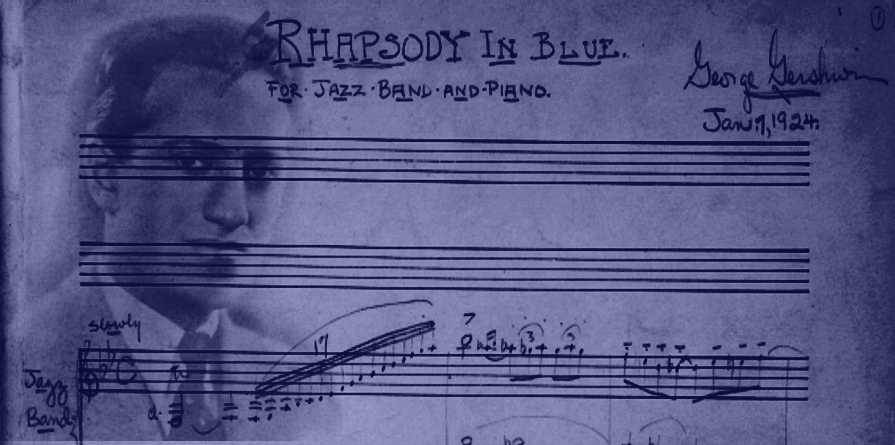 On the afternoon of February 12, 1924, the culmination of a bold musical experiment is unfolding on the stage of New York City's Aeolian Hall. Popular bandleader Paul Whiteman has concluded most of a concert billed as "An Experiment in Modern Music,” and his orchestra is preparing to begin the second-to-last piece in the program. The composer of this new work, a young man named George Gershwin, sits at the piano. The audience is bored and irritable, and those that haven't already gotten up to leave are counting down the minutes until the concert is over. Suddenly, however, a clarinet's wailing glissando cuts through the silence, and the music plunges the stunned audience into a stunning illustration of a world they know so well: A world of highs and lows, triumphs and tragedies, but above all strength and a determination to continue -- the world of New York City itself, and consequently the human spirit. That music was what would become one of the defining compositions of the Jazz Age: "Rhapsody in Blue."
On the afternoon of February 12, 1924, the culmination of a bold musical experiment is unfolding on the stage of New York City's Aeolian Hall. Popular bandleader Paul Whiteman has concluded most of a concert billed as "An Experiment in Modern Music,” and his orchestra is preparing to begin the second-to-last piece in the program. The composer of this new work, a young man named George Gershwin, sits at the piano. The audience is bored and irritable, and those that haven't already gotten up to leave are counting down the minutes until the concert is over. Suddenly, however, a clarinet's wailing glissando cuts through the silence, and the music plunges the stunned audience into a stunning illustration of a world they know so well: A world of highs and lows, triumphs and tragedies, but above all strength and a determination to continue -- the world of New York City itself, and consequently the human spirit. That music was what would become one of the defining compositions of the Jazz Age: "Rhapsody in Blue."
The twenty-six-year-old Gershwin already had a reputation as a musical star on the rise. He had penned the hit song "Swanee" with Irving Caesar in 1919 and had been a significant contributor to the whimsical Broadway revues of George White. Paul Whiteman, who had collaborated with Gershwin on one of those revues, approached him in January of 1924 with the idea of creating a jazz-inspired concerto to be performed at a concert the following month. Gershwin initially turned him down, claiming that it was too little time to compose a piece and perform the needed revisions, but quickly changed his mind and rose to the challenge with only five weeks to spare. Conceived as a musical portrait of the American people, Gershwin sought to capture the country's energy and diversity; in fact, he had originally planned to call the work "American Rhapsody.” Composition began on January 7 and the revisions and orchestration were finished by February 4, giving Whiteman's orchestra eight days to rehearse before the concert.
In composing this bold new piece, Gershwin drew upon themes he was intimately familiar with. Growing up in New York City, he spent three years as a demonstrative pianist in the famed Tin Pan Alley district, which brought him into contact with many different types of people and musical themes and demonstrated his ability to combine a number of different motifs into a single coherent work. He drew upon this experience for the composition of the Rhapsody, combining European classical tradition with themes that represented the struggle and determination of the working class. The synonymy of jazz with dance music was blatantly ignored, the common structure replaced with bluenotes and syncopated rhythms that had found their roots in the traditions Gershwin hoped to represent. The Rhapsody was more than just an attempt to make jazz respectable in the public eye: It was a portrait of America in a microcosm, of a city and its people.
The official premiere of "Rhapsody in Blue" was met with overwhelming acclaim by the audience which erupted into applause almost as soon as it concluded. Nothing quite like it had ever been done before, and it would go on to become Gershwin's most iconic composition. It remained wildly popular in the years that followed; Whiteman performed it over eighty times over the next three years, and recordings of it sold well over a million copies. Critical response was more mixed and ran the gamut from praise to confusion and scorn, but no one could deny that the young composer had created something new and profound. In years to come, the Aeolian Hall concert would be considered a major turning point in the history of popular music, and the Rhapsody itself the epitome of the romance of Jazz Age New York. The iconic opening glissando has been cited as one of the most widely-recognized openings in music, comparable to Beethoven's 5th Symphony.
"Rhapsody in Blue" has also appeared in a number of films since its composition. The earliest of these is 1930s "The King of Jazz," a technicolor musical review featuring Paul Whiteman himself, the very first film appearance of legendary crooner Bing Crosby and some fascinating vaudeville acts such as a musical bicycle pump. A more obvious one is the 1945 biopic "Rhapsody in Blue," starring Robert Alda as Gershwin and featuring a number of Gershwin's real-life acquaintances such as Whiteman, George White, Anne Brown, Al Jolson and Oscar Levant. More recently, the Rhapsody appeared in the 2013 adaptation of "The Great Gatsby" as the titular character's leitmotif.
Interested in learning more? Check out our catalog!


Add a comment to: Rhapsody in Blue: 100 Years of a Jazz Age Classic